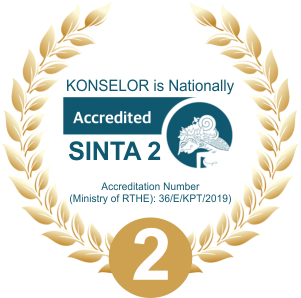Efektivitas Layanan Bimbingan Kelompok dengan Modeling dalam Meningkatkan Efikasi Diri Siswa dalam Menghadapi Ujian
 ), A. Muri Yusuf(2), Marjohan Marjohan(3),
), A. Muri Yusuf(2), Marjohan Marjohan(3), (1) Universitas Negeri Padang
(2) Universitas Negeri Padang
(3) Universitas Negeri Padang
 Corresponding Author
Corresponding Author
Copyright (c) 2017 Konselor
DOI : https://doi.org/10.24036/02016516485-0-00
Full Text:
 Language : en
Language : en
Abstract
Self-Efficacyis the most important factorforstudents’successto face examination,becauseself-efficacy beliefs made a powerful and independent contribution to the prediction of their academic performance.Modeling is one of technique usedto increase itandGroup guidancewas helpful in increasing students’ self-efficacy. This research sought to see the effectiveness of group guidance to increase the students’ self-efficacy through modeling to face examination. The subject of the research was 9 students in class XII of Pesantren Modern Diniyyah Pasia Assumed to have low self-efficacy.This research was classified into pre-experimental research which applied The One Group Pretest-Postest design. The treatment was given throuh modeling in eight meetings. The data were gathered by using self-efficacy scale which had been validated previously. The result of the research revealed that the application of group guidance service through modeling was effective to increase the students’ self-efficacy into better category. The students were confident about their ability to face examination, they were sure that they could maintain themselves, and they had confident to organize their ability to face other situation or condition.
Keywords
References
Alwisol. (2010). Psikologi Kepribadian. Malang: UMM Press.
Bandura, Albert. (2009). Self-Efficacy in Changing Societies. New York: Cambridge University Press.
Feist, Jess dan Gregory J., Feist. (2010). Teori Kepribadian. Jakarta: Salemba Humanika.
Gredler. Margaret. (2009). Learning and Instruction Theory into Practice.New Jersey: Pearson Education. Inc.
Hsu, Pi-Ying. (1999). The Effects of Peer Modeling on Taiwanese College Students’ Self Efficacy and Reading Performance in English Class. Disertation. Texas Tech University .
Mappiare, Andi. (2006). Kamus Istilah Konseling & Terapi.Jakarta: PT Raja Grafindo Persada.
Pajares, Frank. (2005). Self Efficacy During Childhood and Adolescence. Information Age Publishing All Rights of Reproduction in Any Form Reserved.
Papalia, Diane E., dkk. (2009). Human Development (Perkembangan Manusia. Jakarta: Salemba Humanika.
Peraturan Pemerintah Republik Indonesia Nomor 32 Tahun 2013.
Prayitno dan Erman Amti. (2004). Dasar-Dasar Bimbingan dan Konseling. Jakarta: Rineka Cipta.
Prayitno dkk. (1997). Seri Pemandu Pelaksanaan Bimbingan dan Konseling di SLTP. Jakarta: PT Ikrar Mandiri Abadi.
Prayitno. (2005). Layanan Bimbingan dan Konseling Kelompok. Jakarta: Ghalia Indonesia.
Rusmana, N. (2009). Bimbingan dan Konseling Kelompok di Sekolah (metode, Teknik dan Aplikasi). Bandung: Rizki Press.
Santrock, Jhon W. (2007). Remaja. Jakarta: Erlangga. Penerjemah : Benedictine Widyasinta.
Santrock, Jhon W. (2012). Life-Span Development. New York: McGraw-Hill.
Santrock, John. W. (2008). Life-Span Development. New York: McGraw-Hill.
Schunk, Dale H., and Judith L. Meece. (2005). Self-Efficacy Development in Adolescences. By Information Age Publishing.
Solomon, Phyllis., Jeffrey Draine., Edle Mannion., and Marllyn Meisel. (1996). Impact of Brief Family Psychoeducation on Self-Efficacy. Journal. Vol. 22, No. 1.
Usman, Husaini dan Purnomo Setiadi Akbar. (2011). Pengantar Statistika. Jakarta: Bumi Aksara.
Winarsunu, Tulus. (2002). Statistik. Malang: UMM Press.
Yusuf, A., Muri. (2013). Metodologi Penelitian. Padang: UNP Press.
Zimmerman, Barry J. (2009). “Self-Efficacy and Educational Development”; dalam Albert Bandura (Ed), 2009: Self-Efficacy in Changing Societies (hlm. 203). New York: Cambidge University Press.
 Article Metrics
Article Metrics
 Abstract Views : 1815 times
Abstract Views : 1815 times
 PDF Downloaded : 1258 times
PDF Downloaded : 1258 times
Refbacks
- There are currently no refbacks.
Copyright (c) 2017 Konselor







